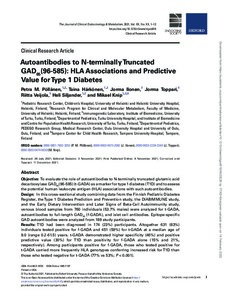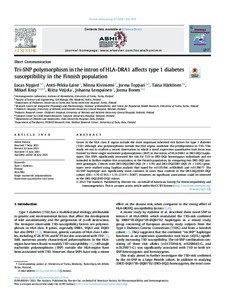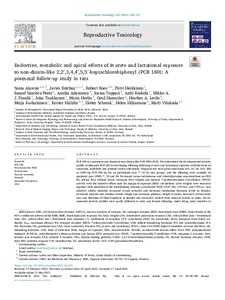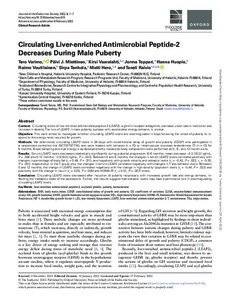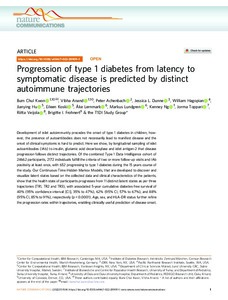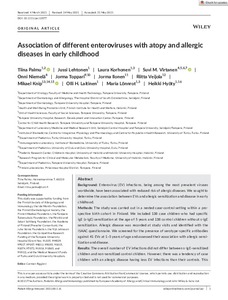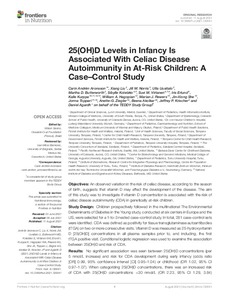Hae
Aineistot 11-20 / 38
Autoantibodies to N-Terminally Truncated GAD65(96-585): HLA Associations and Predictive Value for Type 1 Diabetes
<p><strong>Objective</strong> <br></p><p>To evaluate the role of autoantibodies to N-terminally truncated glutamic acid decarboxylase GAD<sub>65</sub>(96-585) (t-GADA) as a marker for type 1 diabetes (T1D) and to assess the potential HLA-associations with such autoantibodies.<br></p><p><strong>Design</strong><br></p><p>In this cross-sectional study combining data from the Finnish Pediatric Diabetes Register, the Type 1 Diabetes Prediction and Prevention (DIPP) Study, the DIABIMMUNE Study, and the Early Dietary Intervention and Later Signs of Beta-Cell Autoimmunity (EDIA) Study, venous blood samples from 760 individuals (53.7% males) were analyzed for t-GADA, autoantibodies to full-length GAD<sub>65</sub> (f-GADA), and islet cell antibodies. Epitope-specific GAD autoantibodies were analyzed from 189 study participants.<br></p><p><strong>Results</strong><br></p><p>T1D had been diagnosed in 174 (23%) participants. Altogether 631 (83%) individuals tested positive for f-GADA and 451 (59%) for t-GADA at a median age of 9.0 years (range 0.2-61.5). t-GADA demonstrated higher specificity (46%) and positive predictive value (30%) for T1D than positivity for f-GADA alone (15% and 21%, respectively). Among participants positive for f-GADA, those who tested positive for t-GADA carried more frequently HLA genotypes conferring increased risk for T1D than those who tested negative for t-GADA (77 vs. 53%; P<0.001).<br></p><p><strong>Conclusions</strong><br></p><p>Autoantibodies to N-terminally truncated GAD improve the screening for T1D compared to f-GADA and may facilitate the selection of participants for clinical trials. HLA class II-mediated antigen presentation of GAD(96-585)-derived or structurally similar peptides might comprise an important pathomechanism in T1D.</p>...
Tri-SNP polymorphism in the intron of HLA-DRA1 affects type 1 diabetes susceptibility in the Finnish population
<p>Genes in the HLA class II region include the most important inherited risk factors for type 1 diabetes (T1D) although also polymorphisms outside the HLA region modulate the predisposition to T1D. This study set out to ...
Endocrine, metabolic and apical effects of in utero and lactational exposure to non-dioxin-like 2,2 ',3,4,4 ',5,5 '-heptachlorobiphenyl (PCB 180): A postnatal follow-up study in rats
PCB 180 is a persistent and abundant non-dioxin-like PCB (NDL-PCB). We determined the developmental toxicity profile of ultrapure PCB 180 in developing offspring following in utero and lactational exposure with the focus ...
Circulating Liver-enriched Antimicrobial Peptide-2 Decreases During Male Puberty
<p><strong>Context: </strong>Circulating levels of liver-enriched antimicrobial peptide 2 (LEAP2), a ghrelin receptor antagonist, decrease under caloric restriction and increase in obesity. The role of LEAP2 in male puberty, a phase with accelerated energy demand, is unclear.</p><p><strong>Objective: </strong>This work aimed to investigate whether circulating LEAP2 levels are downregulated in boys following the onset of puberty to respond to the energy need required for growth.</p><p><strong>Methods: </strong>We determined circulating LEAP2 levels in 28 boys with constitutional delay of growth and puberty (CDGP) who participated in a randomized controlled trial (<a href="http://clinicaltrials.gov/show/NCT01797718" title="See in ClinicalTrials.gov">NCT01797718</a>), and were treated with letrozole (n = 15) or intramuscular low-dose testosterone (T) (n = 13) for 6 months. Blood sampling and dual-energy x-ray absorptiometry-measured body composition were performed at 0-, 6-, and 12-month visits.</p><p><strong>Results: </strong>Serum LEAP2 levels decreased statistically significantly during pubertal progression (0-6 months: mean decrease -4.3 [10.3] ng/mL, P = .036 and 0-12 months: -3.9 [9.3] ng/mL, P = .033). Between 0 and 6 months, the changes in serum LEAP2 levels correlated positively with changes in percentage of body fat (r <sub>s</sub> = 0.48, P = .011), and negatively with growth velocity and estradiol levels (r <sub>s</sub> = -0.43, P = .022, r <sub>s</sub> = -0.55, P = .003, respectively). In the T group only, the changes in serum LEAP2 correlated negatively with changes in T and estradiol levels. Between 0 and 12 months, the change in LEAP2 levels correlated negatively with the change in high-density lipoprotein levels (r <sub>s</sub> = -0.44, P = .022) and positively with the change in insulin (r <sub>s</sub> = 0.50, P = .009) and HOMA-IR (r<sub>s</sub> = 0.51, P = .007) levels.</p><p><strong>Conclusion: </strong>Circulating LEAP2 levels decreased after induction of puberty reciprocally with increased growth rate and energy demand, reflecting the metabolic state of the adolescent. Further, the results suggest that estradiol levels may have a permissive role in downregulating circulating LEAP2 levels.</p>...
Non-HLA Gene Polymorphisms in the Pathogenesis of Type 1 Diabetes: Phase and Endotype Specific Effects
The non-HLA loci conferring susceptibility to type 1 diabetes determine approximately half of the genetic disease risk, and several of them have been shown to affect immune-cell or pancreatic beta-cell functions. A number ...
Progression of type 1 diabetes from latency to symptomatic disease is predicted by distinct autoimmune trajectories
Development of islet autoimmunity precedes the onset of type 1 diabetes in children, however, the presence of autoantibodies does not necessarily lead to manifest disease and the onset of clinical symptoms is hard to ...
Association of different enteroviruses with atopy and allergic diseases in early childhood
<p><b>Background:</b> Enterovirus (EV) infections, being among the most prevalent viruses worldwide, have been associated with reduced risk of allergic diseases. We sought to determine the association between EVs and ...
25(OH)D Levels in Infancy Is Associated With Celiac Disease Autoimmunity in At-Risk Children: A Case–Control Study
<p>Objectives: An observed variation in the risk of celiac disease, according to the season of birth, suggests that vitamin D may affect the development of the disease. The aim of this study was to investigate if vitamin ...

